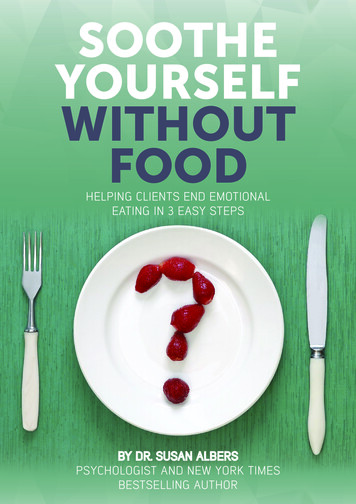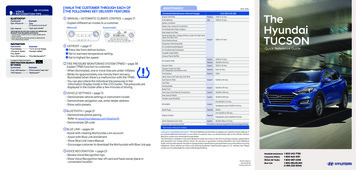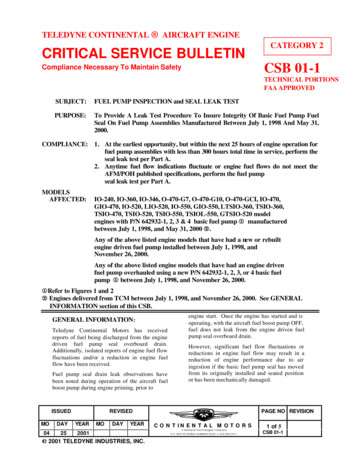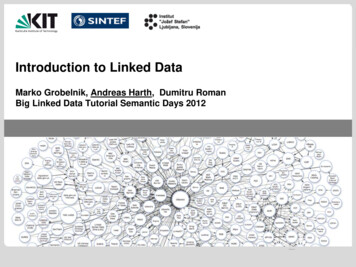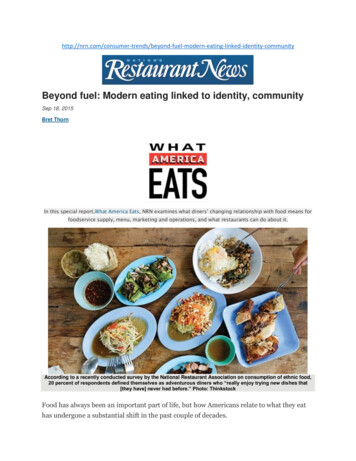
Transcription
eating-linked-identity-communityBeyond fuel: Modern eating linked to identity, communitySep 18, 2015Bret ThornIn this special report,What America Eats, NRN examines what diners’ changing relationship with food means forfoodservice supply, menu, marketing and operations, and what restaurants can do about it.According to a recently conducted survey by the National Restaurant Association on consumption of ethnic food,20 percent of respondents defined themselves as adventurous diners who “really enjoy trying new dishes that[they have] never had before.” Photo: ThinkstockFood has always been an important part of life, but how Americans relate to what they eathas undergone a substantial shift in the past couple of decades.
What was once a source of fuel for everyone, and a source of solace and pleasure for manypeople, is now a vehicle for self-expression, a point of pride, a political statement, adeclaration of identity and much more.Health seems to be on more consumers’ minds, too, although their definition of health, andtheir perception of what’s good for them, has shifted in varying and often contradictoryways.Restaurants have responded by finding new ways to engage with their customers, notmerely with new menu items, but with entire new conversations about how their food issourced, prepared and served.As Yum! Brands Inc. CEO Greg Creed observed at an investor and analyst conference lastyear, consumers, particularly young people, see social responsibility as part of the foodconversation.“From a Millennial perspective in particular, it is good for me and good for we,” the head ofthe parent company of KFC, Pizza Hut and Taco Bell said.With food now woven into many Americans’ sense of identity and place in society, Nation’sRestaurant News takes a look at this state of affairs and what restaurants should be doingabout it.Food as self-expressionIf you’re concerned about the environment, you might be a vegetarian. If animal welfare isyour cause, then you could well be a vegan. Into CrossFit? Then Paleo’s the diet for you.“You are what you eat” might be a cliché, but these days it’s truer than ever as manyAmericans tout their dietary preferences loudly.Market intelligence agency Mintel estimates that more than 29 million Americans haveposted a picture of food or drink from a restaurant via social media, but that’s just the mostliteral form of using what you consume as a way of expressing yourself. These days, whatpeople eat has deeper connotations than merely getting “likes” on Instagram.Psychologist William Hallman, department chair of human ecology at Rutgers University inNew Brunswick, N.J., said people’s eating habits help them identify who they are on manylevels.
On one level are the people — particularly young men, he said — who watch foodcompetition shows and food adventure shows such as “Bizarre Foods with AndrewZimmern” and “Anthony Bourdain: Parts Unknown,” and use them as sources for socialcurrency.Many of the viewers of these shows, Hallman said, don’t cook themselves, but enjoy thecompetition. They also get introduced to new ingredients that then become part of casualconversation, or even a sort of one-upmanship: “Oh, you’ve never tried sailfish roe?”That was the idea behind the jelly doughnut milkshake that Mooyah Burgers, Fries & Shakesadded to the menu earlier this year as a limited-time offer.Michael Mabry, chief operating officer of the 85-unit chain said his team introduced thesomewhat offbeat item to “get people to talk about it and drive them to our shake section,and it worked. The jelly doughnut shake sold relatively well, but shake sales [overall]improved from the same time last year,” he said.Now that food is fashionable, a certain amount of diners want to be trend leaders by beingthe first to try new foods, while others want to try new things for the fun of it. Thisconsumer shift has been exhibited in recent years by widespread acceptance of formerlyobscure ingredients such as hummus — now a supermarket staple — and quinoa.The latter was introduced to casual-dining chains just three years ago, when it was part of avegetarian tasting menu at Darden Restaurants Inc. subsidiary Seasons 52. It wasn’t listedas quinoa, however, but as “grains of life,” because quinoa wasn’t a readily recognizedingredient.The majority of consumers are looking for food adventure.According to a recently conducted survey by the National Restaurant Association onconsumption of ethnic food, 20 percent of respondents defined themselves as adventurousdiners who “really enjoy trying new dishes that [they have] never had before.” Another 56percent of the 1,000 people surveyed said they were open to trying new dishes occasionally.Restaurants have responded to these customers by introducing new ingredients. However,to give those ingredients even broader appeal, the restaurants generally introduce them in acontext that makes them less alienating. For example, Rubio’s Coastal Grill this summerintroduced a new fish, grilled Japanese sea bass, to its 193 locations, but it did it in the formof the chain’s beloved fish tacos.
Culinary adventurism is even more prevalent among younger customers. The NRA ethnicfoods survey found that 29 percent of respondents said they had tried a new ethnic food —defined as food that originated in a different country or that is specific to a certain regionwithin the United States — within the past year. But that figure jumped to 37 percent forpeople aged 25 to 34 and to 48 percent for people aged 18 to 24.Those age groups, as well as people under 18, are also the ones most likely to share picturesof those new foods on social media, adding to their reputation as adventurers and givingrestaurants new reasons to offer foods their guests might not have tried before. Romano’sMacaroni Grill did that this summer with the introduction of Calabrian peppers, a robustchile from Italy that’s appearing on menus at trendy independent restaurants. To make thenew ingredient less of a challenge, the 141-unit casual dining chain introduced it in the formof a pesto made with sundried tomatoes, garlic, lemon juice, sea salt and olive oil as well asCalabrian peppers. To ease the risk even further, it served the pesto as part of anapproachable breaded steak & eggs dish on its new brunch menu.Adventure is one level of food-related self-expression. On another level, many diners, oftenthe same ones keen for culinary adventure, have restricted what they will eat, sometimesbased simply on preference, but often based on real or imagined allergies, or moralconcerns.“I think it allows them to connect with other people,” Hallman said about these restricteddiets. “It’s a signifier. It allows them perhaps to distinguish themselves from other people.”Social pressures can have an effect on diets, too, like when parents judge what other parentsfeed their children, Hallman said.Restaurants have responded with an array of items to suit their customers’ dietary whims,from gluten-free foods to protein-focused bowls and snacks.Dan Kish, senior vice president of food at Panera Bread, said the 1,900-unit fast-casualchain is taking a broader approach, even developing an app and updating its website toaccommodate guests with dietary issues. With the click of a virtual button, customers will beable choose categories including vegan, “gluten conscious,” “protein rich,” and “calorieconscious.” Then the website or app will only show menu items that match those criteriaand even reformulate certain items to make them fit, such as removing croutons from saladsto make them gluten conscious.
Panera’s move also acknowledges another reality of the modern foodclimate: Although people’s diets can give them a sense of belonging,that doesn’t mean their choices are permanent.Laurie Demeritt, CEO of consumer research firm The HartmanGroup, pointed to a recent report on health & wellness by hercompany that found a third of respondents have tried a differentcustomized eating approach over the past 12 months — “doing Paleofor a while, being a vegan for a couple weeks, kind of trying it on andthen discarding it and moving on to something else, since they don’treally necessarily know what’s going to be right for them,” she said.Restaurants should be aware that such life choices could changeevery few weeks, so rather than committing to catering to a specificdietary choice, they should have the flexibility in place within theirsystems to adjust to whatever their customers are looking for,Demeritt said.Power of perceptionIf most Americans are asked, they’ll say they’re trying to eat morehealthfully. But even when they actually act on those claims — and theydo with increasing frequency — what they think of as good for themmight not actually be. That doesn’t merely have to do with salads thatare unexpectedly 1,200 calories (dressing, croutons and cheese cansneak up on you). Consumers often confuse terms that seem healthful,like “fresh” and “natural,” with actually healthful food. A naturallyraised, local, sustainable slab of pork belly has just as many calories asany other kind of bacon, for example, and with obesity remaining the single biggest healthchallenge in the United States, calories are important.“If you’re a nutritionist or a dietitian, you think about health and wellness as very structured— how many calories, how much fat, what’s the right balance of fiber, and protein, etc,”Demeritt said. “If you’re a [health & wellness] professional, you think that’s what health andwellness means to a consumer. It by no means does.”In fact, according to the Hartman Group’s recent report, the 13 percent of consumers mostengaged with health & wellness think of it as “being attuned and connected to mind, body,soul, relationships and the wider world.” This mindset on health and wellness translates tobuying sustainable, humanely raised and locally sourced items all fit into their notion of
their own well-being, and what Demeritt refers to as “fresh, real [and] minimally processedfoods.”That reality is clear to restaurant operators at all levels, whose job is not to police the dietaryhabits of their customers but to sell them food that they want to eat. In response toconsumers’ interest in “cleaner” food, restaurants ranging from Panera Bread to PapaJohn’sto Subway have moved to strip artificial ingredients from their food while other largechains, including chicken sandwich giant Chick-fil-A, have committed to buying proteinraised without antibiotics. CKE Restaurants Inc. subsidiaries Carl’s Jr. andHardee’s nowoffer a burger made with naturally raised beef — free of added hormones or antibiotics —and smaller, younger chains, such as 28-unit better burger chain Bareburger, have suchpurchasing practices as part of their corporate DNA.Creed of Yum Brands said the fact that “fresh and real” foods aren’t necessarily better foryou, is beside the point.“I can argue the facts, but the facts don’t matter, because it’s the perception, the perceptionis the reality,” he said.He added that Yum Brands should shift towards food that is “real” and affordable.Management of Pudgie’s Famous Chicken, a legacy brand on Long Island in New York thatis now down to three-units, has made a similar observation and is in the process ofrebranding.Gary Occhiogrosso, president and chief development officer of Truefoods, which owns thePudgie’s brand, said the chain started shifting emphasis away from its signature skinlessfried chicken with a prototype it opened a year ago in Massapequa, N.Y. The skinless friedchicken has a more healthful perception than other fried chicken since it doesn’t have thehigh-fat skin, but it is still fried chicken. The new unit was given a new name: Pudgie’sNaked Chicken.“Most people just call it Naked Chicken now,” he said, noting that he plans to drop the“Pudgie’s” in future branding.The word “naked,” apart from being fun marketing, made reference to the chain’s signaturedish, still an important part of the menu, and also implied a cleanness and purity expressedin new items, such as salads, brown rice bowls and a grilled chicken sandwich.
“The general public today looks toward cleaner eating and healthful options,” he said,noting that they love fried chicken but understand the need to eat other things, too.Giving control to the consumerCustomizability, and how that resonates with guests, is often cited as a reason for thecurrent success of the fast-casual segment. Never mind that Burger King was inviting itscustomers to “Have it your way” in the 1970s, or that Subway started assembling food infront of customers long before Chipotle had even been conceived. The open-kitchen feel andovert involvement of customers in the construction of their meals has given those customersa sense of empowerment that makes them feel good about eating a 1,000-calorie Chipotleburrito, when they would have felt bad about eating a 540-calorieMcDonald’s Big Mac.Hallman said that people sometimes feel better about what they’re eating just by doingsomething about it — practically anything, in fact, such as deciding to put a little bit lessguacamole on their burrito.“When you give people a sense of control they can feel better,” Hallman said. “Giving themsomething to do, an activity which gives them the illusion of control, can work wonders.”That might be why the easy customization that’s a hallmark of fast-casual restaurants hassuch appeal.Drew French, founder of Your Pie, a 22-unit fast casualpizza chain, said he established the chain with the ideathat it would have a “user-generated menu.”“That’s why we call it Your Pie to begin with,” hesaid.The chain’s messaging focuses on asking customerswhat they like on their pizza. “We added gluten-free dough because people kept coming inwith their own dough and asking us to use it,” he added.“What customers like about Your Pie and our [fast-casual] style in general is they can seewhat they’re putting in their bodies. A lot of it is about what they can see and smell andtouch and feel,” he said.
But the restaurant also benefits from customer suggestions, which currently is inspiringtheir “Craft Series” of pizzas that use seasonal ingredients. In August that was a peach andprosciutto pizza.“It’s about giving customers access to the brand and asking for their feedback, and thenhopefully giving them what they want,” French said.What customers say and what they doWith high and sometimes contradictory expectations for food, many consumers are settingthemselves up for disappointment. It’s a tall order to have reasonably priced, delicious,nutritious, humanely raised, sustainable, local food on hand for every meal.As a result, people often pick and choose their values, Hallman said, deciding, for example,to ignore the fact that their strawberries aren’t local because they want to make strawberrycheesecake for Thanksgiving.Or people will engage in what Hallman calls “psychological bargaining,” such as drinking adiet soda and rewarding yourself with a slice of pecan pie.Or, as number crunchers at the online ordering platform Olo observed, eating meals theyfeel are good for them early in the week and blowing their diets on Friday.At NRN’s request they looked at three national burger chains and how their sales evolvedover the course of the work week. Although they couldn’t divulge the brands’ names forconfidentiality reasons, all three displayed slow sales on Monday, which then spiked as theweek progressed. They saw a similar increase at a national wing chain, with sales as much as75 percent higher on Friday than on Monday.Conversely, a salad brand saw sales on Friday that were 43 percent lower than they were onMonday, indicating that chains with solid health halos might consider offeringcheeseburgers on Fridays, or that burger chains might consider highlighting some lighteritems earlier in the week.Apart from the psychological games we all play to justify our choices, sometimes therealities of everyday life intervene at meal times.
Stan Dorsey, chief strategy officer for The Center for Generational Kinetics, a research firmthat focuses on Millennials, said that, as we observe this ongoing evolution of Americans’interaction with food, there are still fundamental aspects of eating that remain unchanged.“Sometimes it comes down to cost and it comes down to speed,” he said. “If you’re at lunch,you need to get in and get out. There’s a chance that you’re going somewhere that’s probablynot as healthy that will get you out faster and that will meet your needs at that time.”As much as people might be concerned about social justice and a clean planet and their ownhealth, sometimes they’re hungry and just want to eat lunch.Contact Bret Thorn at bret.thorn@penton.com.Follow him on Twitter: @foodwriterdiary
are unexpectedly 1,200 calories (dressing, croutons and cheese can sneak up on you). Consumers often confuse terms that seem healthful, like "fresh" and "natural," with actually healthful food. A naturally raised, local, sustainable slab of pork belly has just as many calories as



